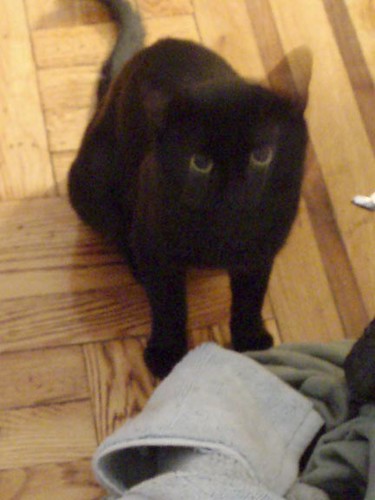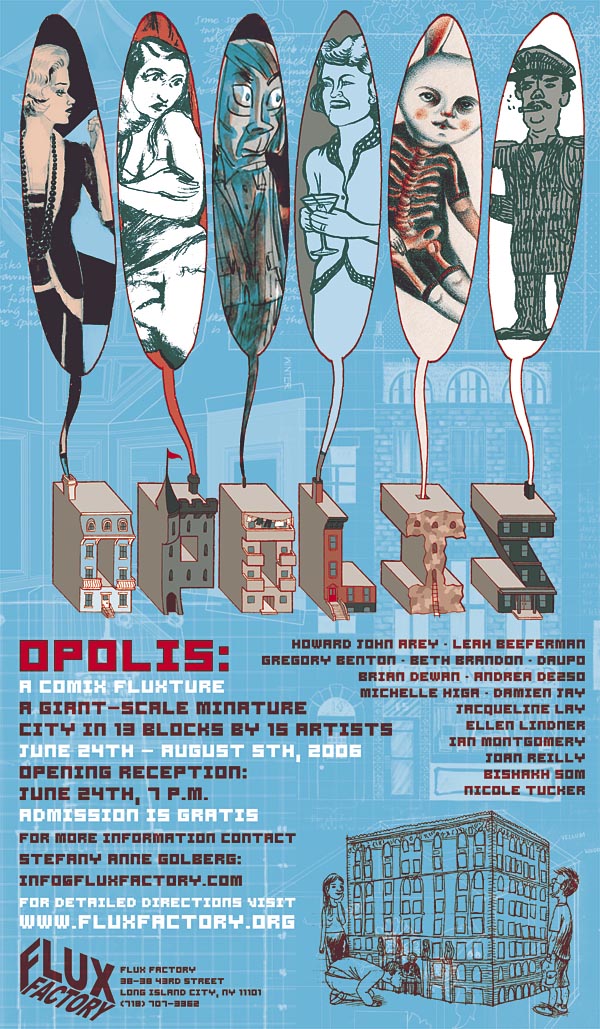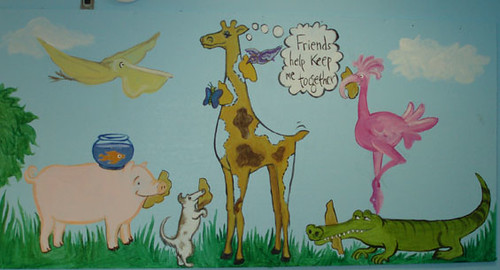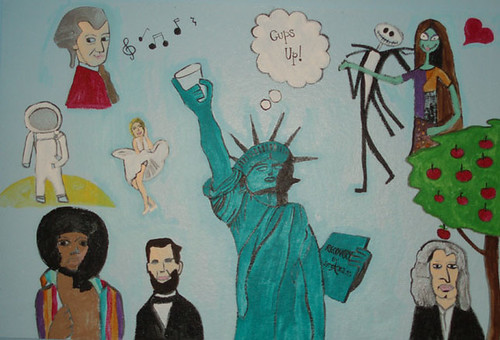Tuesday, August 29, 2006
Mister Never gets press
Drawing on New Orleans...
On this anniversary of the flood in the Gulf Coast, I thought you might like to see some work that was published in today's New York Times Op-Ed section including the work of MassArt alumnus, Jeff Marshall (MFA '00). To mark the anniversary of Hurricane Katrina, the Op-Ed page asked artists who either live or have spent considerable time in New Orleans to draw and write about a place of particular importance to them in the city.
Click here to view work by DAVID ROBERTS, KAROLINE SCHLEH, JACQUELINE BISHOP, JEFFREY MARSHALL, PAUL ROGERS, MYRTLE VONDAMITZ and KYLE BRAVO. Click here to view more of Jeff Marshall's work and the background to his New Orleans drawing project.
Les is more...

Sunday, August 27, 2006
What! I'm Listening to (part 4):
"Acoustical Liberation of books in the public domain"
from NYTimes.com (Public Domain Books, Ready for your Ipod)> by Craig Silverman...LibriVox’s founder, Hugh McGuire, 32, a software developer and writer in Montreal, said there were another 100 works in development, all of which would be recorded, edited and uploaded by volunteers.“The principles of the project are to be totally noncommercial, totally ad free, totally volunteer and totally public domain,” he said.
Noble, not Nobel...
from NYtimes.com
Prestigious Award, ‘Nobel’ of Mathematics, Fails to Lure Reclusive Russian Problem Solver
by Kenneth Chang
Grigory Perelman, a reclusive Russian mathematician who solved a key piece in a century-old puzzle known as the Poincaré conjecture, was one of four mathematicians awarded the Fields Medal yesterday.
But as with previous honors, Dr. Perelman refused to accept this one, and he did not attend the ceremonies at the International Congress of Mathematicians in Madrid.
“I regret that Dr. Perelman has declined to accept the medal,” Sir John M. Ball, president of the International Mathematical Union, said during the opening ceremonies.
The Fields Medal, often described as mathematics’ equivalent to the Nobel Prize, is given every four years. The other Fields medalists this year are Andrei Okounkov, a professor of mathematics at Princeton; Terence Tao, a professor of mathematics at the University of California, Los Angeles; and Wendelin Werner, a professor of mathematics at the University of Paris-South in Orsay, France.
Dr. Perelman, 40, is known not only for his work on the Poincaré conjecture, among the most heralded unsolved math problems, but also because he has declined previous mathematical prizes and has spurned offers from Princeton, Stanford and other universities. He has shown no interest in pursuing the $1 million that the Clay Mathematics Institute in Cambridge, Mass., is offering for the first published proof of the conjecture.
In June, Sir John went to St. Petersburg, Russia, where Dr. Perelman lives, and spent two days trying to persuade him to travel to Madrid to accept the Fields. “He was very polite and cordial and open and direct,” Sir John said in an interview.
And Dr. Perelman was resolute in saying no. “The reasons center around his feeling of isolation from the mathematical community,” Sir John said, “and in consequence his not wanting to be a figurehead for it or wanting to represent it.” He added: “I don’t think he meant it as an insult. He’s a very polite person. There was never a cross word.”
Despite Dr. Perelman’s refusal, he is still officially a Fields medalist. “He has a say whether he accepts it, but we have awarded it,” Sir John said.
Beginning in 2002, Dr. Perelman, then at the Steklov Institute of Mathematics of the Russian Academy of Sciences in St. Petersburg, published a series of papers on the Internet and gave lectures at several American universities describing how he had overcome a roadblock in the proof of the Poincaré conjecture.
The conjecture made by Henri Poincaré in 1904 essentially says that any shape that does not have any holes and fits within a finite space can be stretched and deformed into a sphere. That is certainly true looking at two-dimensional surfaces in the everyday three-dimensional world, but the conjecture says the same is true for three-dimensional surfaces embedded in four or more dimensions.
Dr. Perelman solved a problem other mathematicians had encountered when trying to prove the conjecture using a technique called Ricci flow that smoothes out bumps in a surface and transforms the surfaces into simpler forms.
Dr. Okounkov, born in 1969 in Moscow, was recognized for work linking different fields of mathematics that had seemed unrelated. “This is the striking feature of Okounkov’s work, finding unexpected links,” said Enrico Arbarello, a geometry professor at the University of Rome.
Dr. Okounkov’s work has found use in describing the changing surfaces of melting crystals. The boundary between melted and nonmelted is created randomly, but the random process inevitably produces a border in the shape of a heart.
Dr. Tao, a native of Australia and, at age 31, one of the youngest to win a Fields Medal, has worked in several fields, producing significant advances in the understanding of prime numbers, techniques that might lead to simplifying the equations of Einstein’s theory of general relativity.
Dr. Werner, born in Germany in 1968, has also worked at the intersection of mathematics and physics, describing phenomena like percolation and shapes produced by minute particles jittering randomly in a process known as Brownian motion.
The medal, first awarded in 1936, was conceived by John Charles Fields, a Canadian mathematician, “in recognition of work already done and as an encouragement for further achievements on the part of the recipient.” That stipulation has been interpreted to mean that the award should usually be limited to mathematicians 40 or younger.
Battra...
Update: I have since given up duties as foster parent to Mao...I can only handle one cat at a time...


Wednesday, August 23, 2006
I have a reliable Apple product...
Tuesday, August 22, 2006
I am a foster parent...
got a brindle brown Domestic Short Hair named Roger...I renamed him "Closetman Mao" because the first thing he did was go to my closet and stay there
for almost the whole first day...It is the second day that he has been with me and he has since spent most
of the time out of the closet...He is a sweetheart, really affectionate...
Update: There is a bit of controversy surrounding BAFN...They seem to have a very high turnover rate and there are claims that the founder is only in it for the money which does not go back to foster care...Any rescue organization is going to be costly...I am undecided on whether or not BAFN is shady...I don't know them well enough, but I have been warned through comments on Craig's List...
Monday, August 21, 2006
Don't know much about history...
Diversity brings breadth to U.S. History
By ERIN TEXEIRA, AP National Writer
Sun. Aug. 20, 2006 11:01 PM
American students often get the impression from history classes that the British got here first, settling Jamestown, Va., in 1607. They hear about how white Northerners freed the black slaves, how Asians came in the mid-1800s to build Western railroads. The lessons have left out a lot. Forty-two years before Jamestown, Spaniards and American Indians lived in St. Augustine, Fla. At least several thousand Latinos and nearly 200,000 black soldiers fought in the Civil War. And Asian-Americans had been living in California and Louisiana since the 1700s.
Now, more of these and other lesser-known facts about American minorities are getting more attention. The main reason is the nation's growing diversity.
More than one in four Americans is not white, and many minority groups are gaining strength — in numbers, political clout and resources — to bring their often-overlooked histories to light.
Minority communities "are yelling for inclusion in the national consciousness," said Gary Okihiro, a historian at Columbia University. "One needs to understand what's true about the past to be able to make sound judgments about our present."
There are hundreds of efforts — big and small — under way to tell the untold stories.
Although Hispanics are the nation's largest minority group — 14.5 percent of the population according to Census Bureau figures released last week — there is no national museum dedicated to their history.
Democratic Rep. Xavier Becerra (news, bio, voting record) of California is pushing a bill to study building one on the National Mall in Washington. "When you walk the Mall in the capital of the United States, there is no better place to try to understand what Americans are and where we have been," Becerra said. "But it's still an incomplete picture."
The Mall has dozens of sites highlighting American culture and history, including the National Museum of the American Indian that opened in 2004, 20 years after it was authorized. Organizers in June settled on the future site of the National Museum of African American History and Culture, but its opening date is still years away. A Latino museum would be even further off.
Other federal agencies are shifting their work to incorporate more minorities' stories. Six years ago, National Park Service historians met to reevaluate how park sites tell the story of the Civil War, said Donald W. Murphy, deputy director of the parks. Old battlefield exhibits mainly discussed who fought and how many died. Now they include personal diaries, including those kept by slaves.
Once considered marginal to American history, those stories are "really important because oftentimes the margins really are the holders of American democracy," said Okihiro, an expert in Asian-American history. "They are those who have fought against their own racial profiling and fought for the freedoms that the majority seem to take for granted."
Asian-Americans are the only immigrants in U.S. history to have faced laws explicitly written to bar their entry — laws that were not overturned until immigration reform in the 1960s, said Dmae Roberts, whose eight-hour public radio program on Asian immigration, "Crossing East," airs on hundreds of stations.
"People know very little of this outside of California," she said.
Some tales have gone untold because, in the less-diverse America of the past, minorities didn't make the decisions on textbooks and other means of passing along history. And in many cases, minorities who had faced blatant discrimination wanted to discard evidence of past horrors.
But some who came of age during the civil rights movement are determined to pass the stories on. "It is so important that children of color are not made to feel that they're asking for anything — they're claiming what's rightfully theirs just like any other child," said Cynthia Morris Lowery, executive director of the African American Experience Fund. "I tell my grandchildren 'Grandpa has earned that spot for you.'"
Sometimes, history is recalled through criminal investigations.
Prosecutors in Jackson, Miss., last year exhumed the remains of Emmett Till, a black teenager killed in 1955 for allegedly whistling at a white woman. Medical examiners performed a new autopsy, and investigators are poring over thousands of documents.
Florida's attorney general ended an investigation last week into a 1951 house bombing that killed two civil rights activists. The probe found extensive circumstantial evidence pointing to four Ku Klux Klan members, all of whom are dead, Attorney General Charlie Crist said Wednesday.
Technology advances also have fueled new interest in history.
In Connecticut last month, archaeologists excavated the grave of an 18th century slave named Venture Smith in hopes that DNA evidence could verify tales of amazing physical strength and a childhood in Guinea, West Africa. No DNA traces were found, but the graves of his wife and children also will be examined.
Paul Beaty of Dallas turned to DNA testing when, after a decade of genealogical research, he could not trace his roots earlier than the 1830s due to incomplete slavery records. The tests linked him to the Ewondo tribe in Cameroon, West Africa, and when his son was born last month, he was named Evan Ewondo.
"We make the connections in America and make the connections in Africa and now we understand our lives," he said. "Now we can build bigger relationships. We are truly creating history." The quest to get the stories told is hardly over.
Though there are more than 12 million Asian-Americans, Roberts said it's tough to persuade stations to air her program, which is being broadcast through next May. "There are stations that haven't quite decided — they say 'We don't have any Asians here,'" Roberts said. "I tell them 'This isn't for Asians. This is for everyone else.'"
Sunday, August 20, 2006
Friday, August 18, 2006
Joan's mural at South Beach...
a pleasure to get down with...
South Beach Hospital Mural
Wednesday, August 16, 2006
New-clear...

from discover.com
America plans its first nuclear warhead in two decades
by Alex Stone
Everything has an expiration date—even nuclear warheads. Concerned that the United States' 10,000-strong stockpile of atomic bombs are past their prime, scientists at Lawrence Livermore National Laboratory in California and Los Alamos National Laboratory in New Mexico are vying to design the first new nuclear bomb in the United States since the W88 warhead in the mid-1980s. The bomb, dubbed the Reliable Replacement Warhead, "is the next logical step," announced the Department of Energy, which sponsors the design competition and is expected to select a winning model for development—pending congressional approval—later this year.
As countries like North Korea and Iran acquire or approach nuclear capability, the program may sound long overdue. And even though the half-life of weapons-grade plutonium is 24,000 years, some experts have suggested that alpha particles emitted as the plutonium decays could crack the pits in the bombs that contain it within 15 years. But careful analysis of old warheads by the Energy Department turned up no signs of weakness, raising questions about the need for new nukes.
To avoid violating international antitesting treaties, the stockpile is kept up to date via a $6 billion-a-year recertification program that tests existing weapons for signs of corrosion. "They take out pits from old weapons and find that all these potential problems are not occurring," explains Ivan Oelrich, a physicist at the Federation of American Scientists. "The consensus is that plutonium pits will be stable for at least 90 to 100 years." What's more, a new warhead might undercut efforts to discourage nuclear proliferation abroad. "It's hypocritical for us to call for other nations to stop their nuclear goals when the United States seems to be pushing its own nuclear program," says Robert Nelson, a physicist at the Union of Concerned Scientists. "We should be doing everything we can to discourage other countries from developing nuclear weapons."
Everything changes, even the planets...
by Seth Borenstein, AP Science Writer
WASHINGTON - The idea that our nine-planet solar system may soon join the obsolete world of eight-track tapes and slide rules should send science teachers, textbook writers and toymakers back to the cosmic drawing board.
"This is, of course, a huge headache for publishers," said Gilbert Sewall, director of the American Textbook Council, a New York-based research institute that follows educational textbooks. Last-minute changes are expensive, but won't break any publisher, he said.
For example, Pearson Prentice Hall has science texts for next year going before California's textbook approval board and will try to get the 12-planet revision in for the state officials to review, said Julia Osborne, the publisher's science editorial director.
"It's worth it because this is such an exciting thing," Osborne said. But 2006 textbooks are already at schools, she said, so for "most students this fall it will be out of date."
Because schools keep textbooks for five to 10 years, it will be about seven years before most school books have 12 planets in them, said Osborne and Sewall.
The world's astronomers are likely to open the solar system doors to three new planets: Ceres, Charon, and one nicknamed Xena to be renamed later.
South Korean "Smart Clothing"
by the Associated Press
SEOUL, South Korea isn't happy making only MP3 players and the memory chips that go inside many of the more popular models. It also wants people wearing South Korean "smart" clothes with built-in digital music players.
Since 2004, smart-apparel development has involved a range of research institutes, universities and conglomerates with the active support of the South Korean government. The government even has estimated that the global market for digital clothing could be $7 billion by 2014. South Korea wants more than 20 percent of it.
Friday, August 11, 2006
Before you drink that cup of coffee...

The effects of caffeine (drug-dosed flies) on web-making...Check out other drug effects on spiders...
Wednesday, August 09, 2006
Is it really possible?
BERLIN (Reuters) - A German scientist has been testing an "anti-stupidity" pill with encouraging results on mice and fruit flies, Bild newspaper reported Saturday.
It said Hans-Hilger Ropers, director at Max-Planck-Institute for Molecular Genetics in Berlin, has tested a pill thwarting hyperactivity in certain brain nerve cells, helping stabilize short-term memory and improve attentiveness.
"With mice and fruit flies we were able to eliminate the loss of short-term memory," Ropers, 62, is quoted saying in the German newspaper, which has dubbed it the "world's first anti-stupidity pill."

My buddy Ed's daughter in her first movie...

Here's info on Hannah Hodson's Television debut.
The Ron Clark Story
Sunday, August 13 at 8:00 and 10:00 p.m. and Thursday, August 17 at 9:00
and 11:00 p.m. ET/PT
Inspired by a true story, TNT brings you the uplifting tale of Ron
Clark, a teacher who leaves his small town in North Carolina to teach in
a New York public school. Despite the obstacles set forth by his
environment and his students, he defies the odds and is able to change
lives while teaching the kids the meanng of success.
Monday, August 07, 2006
Mood art?
Electronic art changes to suit mood of viewer
LONDON (Reuters) - Beauty may be in the eye of the beholder, but the latest electronic artwork is all about the viewer's mood.
British and American computer scientists have developed artwork that changes according to how the viewer feels. Special software picks up facial cues and adapts the color and brush strokes of the digital image.
"The programme analyses the image of eight facial expressions, such as the position and shape of the mouth, the openness of the eyes, and the angle of the brows, to work out the emotional state of the viewer," said Dr John Collomosse of the University of Bath in southwest England.
"It does all of this in real time, meaning that as the viewer's emotions change the artwork responds accordingly," he added in a statement.
"This kind of empathic painting only needs a desktop computer and a webcam to work, so once you have the programme and have calibrated it for the individual viewer, you are ready to start recreating personalised art based on your mood," Collomosse explained.
Fidel, Cubans feeling fowl...
By Jeff Franks Fri. Aug. 4 9:37 AM
Miami-REUTERS-The bird has reason to be nervous, because the illness of Cuban leader has moved adherents of Santeria to appeal for divine help in hastening either Castro's demise or his recovery, depending on which side of the Florida Straits they live.
Santeria is the voodooish Afro-Cuban religion that uses animal sacrifice to communicate with the gods, which makes these tough times for favorite sacrificial creatures such as chickens, goats and, in this case, doves.
As many as 3 million people in Cuba and 60,000 people in Florida are believed to be involved in Santeria, according to religious experts.
Osorio said about 20 people a day are coming into his "botanica" in Miami's Little Havana section to buy birds, powders and jewelry for rituals in which they ask the gods to please finish off Castro so they can return home.
The white doves are most popular at the moment because, as traditional symbols of peace, their significance is as much political as religious.
Friday, August 04, 2006
Opolis

Joan Reilly is part of this show...She's doing an architectural cityscape Julia Child timeline piece....Sounds pretty cool...I'm gonna go check it out tomorrow...
Cat parasite responsible for human behavior?
 |
By Ker Than
A parasitic microbe commonly found in cats might have helped shape entire human cultures by manipulating the personalities of infected individuals, according to a new study.
Infection by a Toxoplasma gondii could make some individuals more prone to some forms of neuroticism and could lead to differences among cultures if enough people are infected, says Kevin Lafferty, a U.S. Geological Survey scientist at the University of California, Santa Barbara.
In a survey of different countries, Lafferty found that people living in those with higher rates of T. gondii infection scored higher on average for neuroticism, defined as an emotional or mental disorder characterized by high levels of anxiety, insecurity or depression.
His finding is detailed in the Aug. 2 issue of the journal for Proceedings of the Royal Society, Biology.
Manipulating behavior
T. gondii infects both wild and domestic cats, but it is carried by many warm-blooded mammals. One recent study showed that the parasite makes normally cautious rats outgoing and more prone to engage in reckless behavior, such as hanging around areas frequently marked by cat urine, making the rats easy targets.
Scientists estimate that the parasite has infected about 3 billion people, or about half of the human population. Studies by researchers in the Czech Republic have suggested T. gondii might have subtle but long-term effects on its human hosts. The parasite is thought to have different, and often opposite effects in men versus women, but both genders appear to develop a form of neuroticism called "guilt proneness."
Other studies have also found links between the parasite and schizophrenia. T. gondii infection is known to damage astrocytes, support cells in the brain that are also affected during schizophrenia. Pregnant women with high levels of antibodies to the parasite are also more likely to give birth to children who will develop the disorder.
In light of such studies, Lafferty wondered whether high rates of T. gondii infection in a culture could shift the average personality of its individuals.
"In populations where this parasite is very common, mass personality modification could result in cultural change," Lafferty said.
The distribution of T. gondii could explain differences in cultural aspects that relate to ego, money, material possessions, work and rules, Lafferty added. In some countries, infections by the cat parasite are very rare, while in others nearly all adults are infected.
Adding to cultural diversity
To test his hypothesis, Lafferty looked at published data on cultural dimensions and average personalities for different countries. The countries examined also kept records of the prevalence of T. gondii antibodies in women of childbearing age. Countries with high prevalence of T. gondii infection also had higher average neuroticism scores.
"There could be a lot more to this story," Lafferty said. "Different responses to the parasite by men and women could lead to many additional cultural effects that are, as yet, difficult to analyze."
Lafferty thinks that climate could be an important factor in determining which human populations are infected by T. gondii. The parasite's eggs can survive longer in humid, low-altitude regions, especially at mid latitudes that have infrequent freezing and thawing.
Other factors could also influence infection rates, including how a culture's attitudes about having cats as pets and the hygiene practices of its people.
Despite its association with neuroticism, Lafferty doesn't think all of the cat parasite's effects on human culture are bad.
"After all, they add to our cultural diversity," he said.






